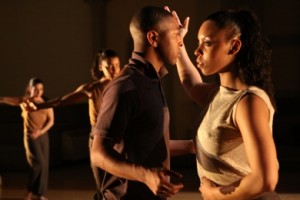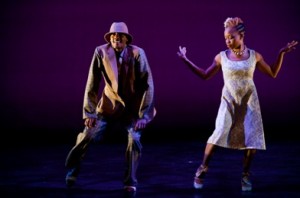JACOB’S PILLOW DANCE
Kyle and Camille
Doris Duke Theatre
August 24-28, 2011
Review by Anna Rogovoy
(BECKET, Mass.) – Kyle Abraham and Camille A. Brown have much in common. Two of New York’s up-and-coming contemporary choreographers, both hits during Jacob’s Pillow’s 2010 summer season, they both make work that is highly physical and steeped in layers of tradition and context. Incidentally, they have been friends for over a decade. But until Pillow director Ella Baff invited them to do a residency together, they had never danced together. The result of the residency is a world premiere duet which closes a lengthy program of works choreographed by the two artists and performed by their respective companies, Abraham.In.Motion and Camille A. Brown & Dancers.
The program opens with Brown’s Been There Done That, a theatrical, snarky duet for herself and Juel D. Lane. Brown, whose expressive face is alternately no-nonsense serious and richly alive, plays the part of an exasperated partner, and she and Lane compete throughout the work, vying for the affection of the audience. When in unison, they struggle to outdo one another; if possible, one steamrolls over the other and takes a solo. When they come together to partner, it’s with the sense that only one of them knows the steps, and the other is desperately trying to keep up. They audibly berate each other throughout, drawing hoots of laughter from the audience.
Been There is followed by excerpts from one of Abraham’s newest works, Live! The Realest MC. Live! begins with dancer Chalvar Monteiro clad in short black shorts and a silver-sequined tank top alone on the stage, lit in a geometric pattern by Dan Scully. Monteiro is a strong interpreter of Abraham’s vocabulary, switching from balletic phrases to undulating hip-hop movements in the blink of an eye, and the femininity inherent in the choreography shines through—at times unabashed, at times shy, yet always genuine. But as soon as Abraham enters the stage, it’s clear who the star of the evening will be.
Kyle Abraham has the kind of perfect placement and specificity that almost go unnoticed because they seem so natural. Capable of isolations so precise that every one of his joints seems unhinged, he has an incredibly relaxed stage presence that renders him utterly nonchalant. And while his technical facilities include the ability to rise to his feet from a seated position by pushing up over the top of his ankle, it’s the subtle way in which movement ripples through his arms that is most admirable. Like Plisetskaya, he embodies a swan, and with it a swan’s duality as a creature of great strength and great grace.
Live! also features exemplary dancing by the other members of Abraham.In.Motion, particularly Rachelle Rafailedes. A tall, striking redhead, Rafailedes is a blur of slashing arms and astonishing forward momentum as she eats up the stage in traveling phrases. And while some of the other dancers may tackle Abraham’s more hip-hop influenced choreography with greater abandon, it’s Rafailedes who best embodies the contrast between sharp and smooth movements that characterize Abraham’s work.
As full of great dancing as it is, there are parts of Live! that begin to drag and could be cut short. But there’s nowhere in the program that begs for editing as much as the later part of Camille A. Brown’s Mr. Tol E. Rance.
Brown’s work, which deals with such themes as religious and racial issues throughout American history, tends toward narrative, a device she typically utilizes effectively. In her 2008 Matchstick, not included on this program but seen previously at the Pillow in 2010, the clear through-line established by the work’s narrative ties together what could have been disparate multidisciplinary elements including complex stage design, text, and live musical accompaniment including voice. And of the three sections of Mr. Tol E. Rance included in this weekend’s program, the two rooted in narrative — and an athletic movement vocabulary — are effective. But the third section seems to rely mostly on several slowly shifting tableaux, an effect that is not strong enough to carry it for the minutes it stretches on. In a quest for clarity, Brown has given us too much, glutting our appetites before she serves the final course.
Following an intermission is Abraham’s The Quiet Dance, which comes as a pleasant contrast to both Live! The Realest MC and Mr. Tol E. Rance. Unlike Live!, where an emphasis on the rough and bravura pervades even the most softly feminine sections, Quiet Dance emphasizes a movement vocabulary centered around soft, deep lunges and crouches, as well as subtle gestures like a slow shrug of the shoulders or flutter of the fingers. And unlike Tol E. Rance, sparingly repeated phrases and a simultaneously dreamlike and direct focus illuminate Quiet Dance’s succinctness.
In City of Rain, which features an original score by Jonathan Melville Pratt and atmospheric lighting by Burke Wilmore, Brown’s choreography takes a grounded turn, and with this turn emerges a standout proponent of her movement. Keon Thoulouis is at once firmly rooted and endowed with lush extensions, enabling his motions to extend beyond his form. He often moves continuously for what seems like minutes, breathtaking in his speed and agility. As he and the five other dancers in the piece (including Brown) spin, roll, and glide, a cloudy sky is projected against the back of the stage, the airy imagery contrasting the earthy feel of the movement. They are human, but it’s possible that the dance has taken them higher than where human movement typically dwells.
The program closes with How We Process, the much-anticipated collaborative duet from Abraham and Brown. Throughout the evening the two choreographers have stood out in their own work, and together, they push each other towards new prowess. Their duet is not combative in the way that Been There Done That is; rather, it seems to be an exploration of how two friends, two artists who respect one another, can come together and enjoy moving together and separately, maintaining an awareness of their shifting relationship.
The score of Process includes each choreographer talking about the other and about the experience of making work together, and Abraham puts it well when he says “dancing with someone … it’s something that’s deeper [than a normal friendship]”.
Deeply attentive to one another and deeply invested in their movement, Kyle Abraham and Camille A. Brown are captivating even as they are backing away from each other, making small gestures of appreciation and closure as the lights fade out.
Anna Rogovoy is the Rogovoy Report’s chief dance critic. She studies dance, literature and writing at Bennington College.


